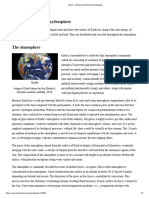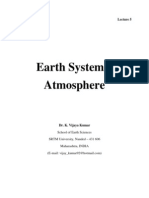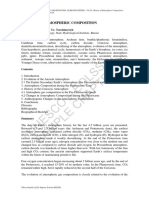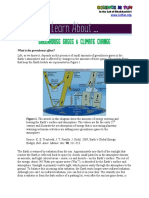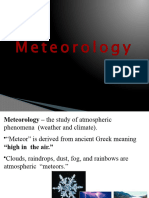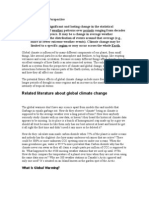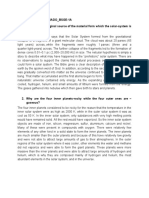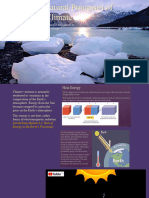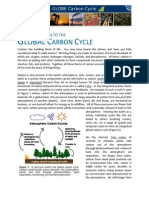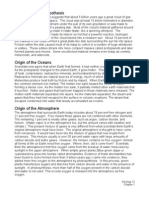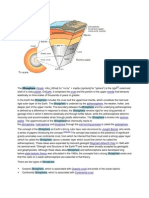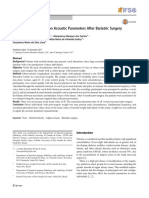La Atmósfera Terrestre
La Atmósfera Terrestre
Uploaded by
Jesús Anibal CisnerosCopyright:
Available Formats
La Atmósfera Terrestre
La Atmósfera Terrestre
Uploaded by
Jesús Anibal CisnerosOriginal Description:
Copyright
Available Formats
Share this document
Did you find this document useful?
Is this content inappropriate?
Copyright:
Available Formats
La Atmósfera Terrestre
La Atmósfera Terrestre
Uploaded by
Jesús Anibal CisnerosCopyright:
Available Formats
The Earth’s Atmosphere – Its Origin, Composition and Properties
2.1 Introduction: Origin of the Earth’s Atmosphere
We know little about the origin of our atmosphere, just as we know little about the origin of our planet. In the
absence of any reliable evidence, one can only speculate. According to cosmologists, our planet most likely
originated from the sun about 4.6 billions of years ago in the wake of the latter’s encounter with a passing
star, following a cosmic event, popularly known as the Big Bang. After its separation from the sun, it started
revolving around the sun under the effect of the sun’s gravitational pull and rotating about its axis like a fiery
ball, surrounded by an extremely hot gaseous envelope which may be called the primordial atmosphere.
However, it may be imagined that the primordial atmosphere at that stage must have been at a great upheaval
as it hurled through space and its hot gaseous envelope rapidly cooled, condensed and solidified forming a
solid crust in the surface layers after giving out considerable amount of volatile hot gases and vapours from
the molten material at the surface. Part of the hot gases and vapours which cooled and condensed into water
formed the world’s oceans. The remainder formed a gaseous envelope around the planet or was stored in
rocks. The atmosphere thus formed had a preponderance of hydrogen and little or no oxygen, so could not
support life of the kind that we know on the earth to-day. However, as the earth cooled down further, complex
chemical actions and reactions in the crust and the interactions between the crust and the atmosphere
gradually led to the formation of an atmosphere which could support an early form of life such as single-
celled microbes which required little oxygen for their survival. Such microbial forms of life, also known as
blue-green algae, perhaps, first appeared in the oceans where they absorbed carbon dioxide and in the
presence of water and sunlight released oxygen by a bio-chemical process known as the green-plant
photosynthesis. The accumulation of oxygen in the atmosphere facilitated the evolution of more complex and
multi-celled forms of life which we observe on our planet to-day. It is believed that all these developments
occurred within the first one billion years of the earth’s history and that, since then, our atmosphere has
gradually stabilized to its present state.
2.2 Composition of the Atmosphere
The gaseous envelope that covers the earth’s surface has no upper limit. It gradually merges into the
interplanetary space. It exists today as a mixture of several gases, the composition of which within the first 25
km of the earth’s surface is presented in Table 2.1. As shown in the Table, nitrogen and oxygen are the two
main constituents of the earth’s atmosphere with their combined proportions approaching almost 99% by
mass as well as by volume. Their compositions vary little with time, so they are treated as permanent gases.
Other gases exist in small amounts only. The proportions of carbon dioxide and ozone are variable. Another
constituent of the atmosphere which finds no place in the Table but is highly important for meteorology is
water vapour which also occurs in small and variable proportion. But, as we shall see later, the three gases,
viz., water vapour, carbon dioxide and ozone, though they occur in small proportions, play very important
roles in atmospheric processes because of their radiative and thermodynamic properties.
The presence of water substance in the atmosphere is especially important, because it can exist in three
phases, viz., vapour, liquid and solid. A change of phase involves either liberation or absorption of a large
quantity of heat which affects atmospheric properties and behaviour. Evaporation of water from the world’s
oceans, condensation of water vapour into cloud and rain in the atmosphere, formation of polar ice caps on
our planet, are all examples of change of phase of the water substance. Minor constituents at low levels of the
atmosphere may include variable quantities of dust, smoke and toxic gases and vapours such as sulphur
dioxide, methane, oxides of nitrogen, etc., some of which pollute the atmosphere and are highly injurious to
health. The above-mentioned composition of the earth’s atmosphere undergoes changes from about 25 km
upward, under the effect of the sun’s ultra-violet radiation. The gases most affected by this process are oxygen
and nitrogen. Their molecules gradually break up leading to formation of ozone in the middle atmosphere
(20–50 km approximately) and atoms and ions (charged particles) in the upper layers of the atmosphere (>
80km). Further discussion about the changes in the composition of air in the upper layers of the atmosphere
will be taken up in Chap. 8. Due to preponderance of diatomic molecules in the atmosphere, the mean gram-
molecular mass of dry air is taken as 28.699. For water vapour, which is triatomic (H2O), the mean
gram-molecular mass is 18.016. We may now, perhaps, address the question raised in Chap. 1 regarding the
loss of lighter elements, especially hydrogen and helium, from the earth’s atmosphere.
According to the kinetic theory of gases, the mean square velocity of a molecule of a gas is directly
proportional to the absolute temperature, as given by the relation 2.2.1 (see, e.g., Saha and Srivastava, 1931,
Fifth corrected edition 1969, reprinted 2003), c2 = 3RT (2.2.1) where c is the molecular velocity, R is the gas
constant and T is the absolute temperature of the gas. Table 2.2 gives the values of the mean molecular
velocity of some of the gases in the earth’s atmosphere at different temperatures. The values are taken
from a paper entitled ‘Is life possible in other planets?’ by Saha and Saha (1939).
However, it may be assumed that our atmosphere had been quite different in the past from what it is to-day,
especially at the time when the earth got separated from the sun and the temperature of the sun, in all
probability, might have been much in excess of the present value of about 6,000 ◦C. At such a high
temperature the mean velocity of the hydrogen atoms would be 12.8km s-1, and that for the hydrogen
molecules would be about 9km s-1. So, a mass like the earth, just separated from the sun, engulfed in hot
gases, would rapidly lose all hydrogen atoms and most of the hydrogen molecules.
But even if the temperature was lower, there would be steady loss of the lighter constituents, for according to
Maxwell’s law of distribution of velocities, all molecules in a gas do not move with the same velocity; there
would be some whose velocities may even at the ordinary temperatures exceed the velocity of escape and
such particles would escape. The rate of loss will increase with higher temperature and lower molecular
weight. Jeans has in fact calculated the time required for loss of planetary atmospheres from different planets
and for different temperatures. He finds that if the mean molecular velocity of the gas is one-fourth the critical
velocity of escape, the atmosphere would be lost in 50,000 years. But if the ratio is one-fifth, 25 million years
would be needed for complete loss. It is probable that the earth’s atmosphere lost most of its primordial
hydrogen, helium and other lighter gases quite early in the course of its geological history,
while the heavier gases were retained.
Table 2.1 Composition of pure dry air
Constituent Gas By Mass (%) By Volume (%) Molecular Wt
Nitrogen (N2) 75.51 78.09 28.02
Oxygen (O2) 23.14 20.95 32.00
Argon (Ar) 1.3 0.93 39.94
Carbon dioxide (CO2) 0.05 0.03 44.01
Neon (Ne) 1.2×10-3 1.8×10-3 20.18
Helium (He) 8.0×10-4 5.2×10-4 4.00
Krypton (Kr) 2.9×10-4 1.0×10-4 83.7
Hydrogen (H2) 0.35×10-5 5.0×10-5 2.02
Xenon(X) 3.6×10-5 0.8×10-5 131.3
Ozone (O3) 0.17×10-5 0.1×10-5 48.0
Radon (Rn) – 6.0×10-18 222.0
Table 2.2 Values of the mean molecular velocity c (km s-1) at different temperatures (◦C) Gas Temperatures (◦C)
-100 0 300
Hydrogen 1.47 1.80 2.66
Helium 1.04 1.31 1.90
Water vapour 0.49 0.61 0.88
Nitrogen 0.39 0.49 0.71
Oxygen 0.37 0.46 0.67
Argon 0.33 0.41 0.59
Carbon dioxide 0.31 0.39 0.57
You might also like
- Evolution Earth AtmosphereDocument8 pagesEvolution Earth AtmosphereMonica UrbietaNo ratings yet
- CH 4 Chemistry of Processes in AtmosphereDocument9 pagesCH 4 Chemistry of Processes in AtmosphereMahnoor ShakeelNo ratings yet
- Module 2Document86 pagesModule 2TharakaNo ratings yet
- Geol-227 Ch-1 - A Changing PlanetDocument15 pagesGeol-227 Ch-1 - A Changing Planetcelinaradwan16No ratings yet
- Awal Evolusi AtmosferDocument16 pagesAwal Evolusi AtmosferRirin lestariNo ratings yet
- Earth - Britannica Online EncyclopediaDocument5 pagesEarth - Britannica Online EncyclopediagutenmorgenmedienNo ratings yet
- Instructor Man and Test Bank 1-19Document446 pagesInstructor Man and Test Bank 1-19Benjamin Silliman100% (1)
- Earth Systems: Atmosphere: School of Earth Sciences SRTM University, Nanded - 431 606 Maharashtra, INDIADocument12 pagesEarth Systems: Atmosphere: School of Earth Sciences SRTM University, Nanded - 431 606 Maharashtra, INDIAMangam RajkumarNo ratings yet
- Unesco - Eolss Sample Chapters: History of Atmospheric CompositionDocument10 pagesUnesco - Eolss Sample Chapters: History of Atmospheric CompositionSharneel ShamalNo ratings yet
- AtmosphereDocument19 pagesAtmospheremsNo ratings yet
- 19 The Ocean-Atmosphere SystemDocument16 pages19 The Ocean-Atmosphere SystemLuisa LouisaNo ratings yet
- Environmental Science Notes Outline Unit 16: Climate ChangeDocument10 pagesEnvironmental Science Notes Outline Unit 16: Climate ChangeMa. Herlisa DuabeNo ratings yet
- Epjconf 1020Document14 pagesEpjconf 1020xegapi4584No ratings yet
- Chem Pre Final and WorksheetDocument10 pagesChem Pre Final and WorksheetReyy ArbolerasNo ratings yet
- AtmosphereDocument14 pagesAtmosphereCHRISTY BASILLANo ratings yet
- Greenhouse Gases 2017Document11 pagesGreenhouse Gases 2017AnusheenNo ratings yet
- Unit 05 AtmosphereDocument9 pagesUnit 05 Atmospherebrijendraahirwar112No ratings yet
- Class10 - Introduction To Earth SystemDocument16 pagesClass10 - Introduction To Earth Systemsahamitrajit477No ratings yet
- On Terraforming MarsDocument6 pagesOn Terraforming MarsJIANANo ratings yet
- Meteorology 1Document35 pagesMeteorology 1Lacanilao, Maureen Jaime C.No ratings yet
- Year 10 Earth and Space Sciences Week 4 and 5Document6 pagesYear 10 Earth and Space Sciences Week 4 and 5Ryan WNo ratings yet
- Atmosphere: Course: Environmental Planning & Practice (3671) Semester: Spring, 2020 Assignment - 1Document7 pagesAtmosphere: Course: Environmental Planning & Practice (3671) Semester: Spring, 2020 Assignment - 1adeel raziNo ratings yet
- Climate Change ReviewerDocument5 pagesClimate Change ReviewerFlorie Mae ViernesNo ratings yet
- Climate Change ReviewerDocument11 pagesClimate Change ReviewerFlorie Mae ViernesNo ratings yet
- RegineDocument8 pagesRegineKen Dela Cruz CopinoNo ratings yet
- Origin of The OceansDocument6 pagesOrigin of The OceansSergio CrepaldiNo ratings yet
- Module 1 Lesson 1Document6 pagesModule 1 Lesson 1MARK BRIAN FLORESNo ratings yet
- GlobalchangeDocument9 pagesGlobalchangeapi-19643403No ratings yet
- The Greenhouse Effect and Climate ChangeDocument37 pagesThe Greenhouse Effect and Climate ChangeSwapnil RathodNo ratings yet
- AtmosphereDocument24 pagesAtmosphereRirin lestariNo ratings yet
- Climate Science Basics: Ian BeardsleyDocument19 pagesClimate Science Basics: Ian BeardsleyIan BeardsleyNo ratings yet
- Christian Paul P. Buado - Bsge-1A 1. What Was The Original Source of The Material Form Which The Solar-System Is Derived?Document4 pagesChristian Paul P. Buado - Bsge-1A 1. What Was The Original Source of The Material Form Which The Solar-System Is Derived?David SamuelNo ratings yet
- Module 7.1. Natural Processes of Variations in Climate Dot Point 1Document16 pagesModule 7.1. Natural Processes of Variations in Climate Dot Point 1Kaira JogNo ratings yet
- 002 Green HouseDocument4 pages002 Green HouseBiraj DasNo ratings yet
- CarbonCycleBackground PDFDocument12 pagesCarbonCycleBackground PDFMusdq ChowdhuryNo ratings yet
- Global Climate SystemDocument3 pagesGlobal Climate SystemAnne WabanNo ratings yet
- CJR English For ChemistryDocument7 pagesCJR English For ChemistrySholeh KNo ratings yet
- Electives 1Document13 pagesElectives 1Arrianne Jaye MataNo ratings yet
- Kurosawa Impact Des Sic Cation Venus 2015Document46 pagesKurosawa Impact Des Sic Cation Venus 2015Jovana StojkovićNo ratings yet
- Clarification NeededDocument1 pageClarification Neededsilakalantari4No ratings yet
- The AtmosphereDocument11 pagesThe AtmospherebarugahareplantonNo ratings yet
- Protoplanet HypothesisDocument1 pageProtoplanet Hypothesiscrazysambitpanda100% (1)
- The Carbon CycleDocument8 pagesThe Carbon CycleDavid Vargas CedielNo ratings yet
- Structure of atmosphereDocument2 pagesStructure of atmosphereAlejandro Carlos CaleroNo ratings yet
- Structure and Composition of The Earth's AtmosphereDocument3 pagesStructure and Composition of The Earth's AtmosphereIncrameezNo ratings yet
- Earth and The Early Atmosphere TimelineDocument1 pageEarth and The Early Atmosphere Timelinemaddy kreiderNo ratings yet
- Atmosphere - WikipediaDocument36 pagesAtmosphere - Wikipediamehdi512shah60No ratings yet
- The Early AtmosphereDocument2 pagesThe Early AtmosphereMary Rose Bobis VicenteNo ratings yet
- CHEM 124 Group 5 Chemistry of The Atmosphere Written ReportDocument12 pagesCHEM 124 Group 5 Chemistry of The Atmosphere Written ReportsiegfredmauroNo ratings yet
- DESASTRESDocument4 pagesDESASTRESGABRIELA GARCIA CUPITRENo ratings yet
- Greek Planet Earth Crust MantleDocument20 pagesGreek Planet Earth Crust MantleBryan FielNo ratings yet
- The Next Layer, The Transition Region Comprises 7.5% of Earth's Mass With A Depth of 250-406Document2 pagesThe Next Layer, The Transition Region Comprises 7.5% of Earth's Mass With A Depth of 250-406Beaulah Hepzibah Cangco CabertoNo ratings yet
- TextbookDocument398 pagesTextbookGary RuleNo ratings yet
- Earth Systems Science: I) Ice Age Vs GlaciationDocument9 pagesEarth Systems Science: I) Ice Age Vs Glaciationይቴ ስንሻዉNo ratings yet
- Research DioknoDocument6 pagesResearch DioknoUlyao Gorospe DioknoNo ratings yet
- SCIENCE 10 Module 8Document5 pagesSCIENCE 10 Module 8Jeff Rey Casiño DalubatanNo ratings yet
- Unit 2 Exam Questions Page371 376Document34 pagesUnit 2 Exam Questions Page371 376nonkumahlobo857No ratings yet
- Chapter 3Document12 pagesChapter 3Jaypee MelendezNo ratings yet
- Solenoid Lifting Lug AnalysisDocument4 pagesSolenoid Lifting Lug AnalysisGiuliano PaoliniNo ratings yet
- Wijers, 2009Document9 pagesWijers, 2009rnvisNo ratings yet
- Computer Vision Used in Self-Driving CarsDocument30 pagesComputer Vision Used in Self-Driving Carsjaseem CKNo ratings yet
- The MOSFET Current MirrorDocument5 pagesThe MOSFET Current MirrorSandeep Pandey100% (2)
- Sources and Cost of Finance Dividend Policies:: 1.1 Capital StructureDocument6 pagesSources and Cost of Finance Dividend Policies:: 1.1 Capital StructureArban SikanderNo ratings yet
- Teach YourselfDocument17 pagesTeach YourselfVedant KhareNo ratings yet
- 41 Circular 2024Document6 pages41 Circular 2024baldman981No ratings yet
- LTE - PresentationDocument19 pagesLTE - PresentationkrafiqueNo ratings yet
- (Springer Series in Optical Sciences 110) Dr. Valerio Lucarini, Professor Dr. Kai-Erik Peiponen, Dr. Jarkko J. Saarinen, Dr. Erik M. Vartiainen (auth.) - Kramers-Kronig Relations in Optical Materials .pdfDocument164 pages(Springer Series in Optical Sciences 110) Dr. Valerio Lucarini, Professor Dr. Kai-Erik Peiponen, Dr. Jarkko J. Saarinen, Dr. Erik M. Vartiainen (auth.) - Kramers-Kronig Relations in Optical Materials .pdfOussama Ikhlef100% (2)
- Asid, Bes Dan GaramDocument6 pagesAsid, Bes Dan GaramTENGKU AHMAD NAQIUDDIN BIN TENGKU NADZUAN MoeNo ratings yet
- 03a EvaporationDocument39 pages03a EvaporationAgustino WaitihacheNo ratings yet
- Formula Sheet PDFDocument2 pagesFormula Sheet PDF蒲俊雄No ratings yet
- NEW KST Presentation Green Telecom TowersDocument8 pagesNEW KST Presentation Green Telecom TowersKannanShreenivas WindenggNo ratings yet
- Spinreact .Creatine Kinase MB (CK-MB)Document4 pagesSpinreact .Creatine Kinase MB (CK-MB)m sdNo ratings yet
- Iso 4327Document3 pagesIso 4327Manoj ChepeNo ratings yet
- Graphitization of Cast IronDocument53 pagesGraphitization of Cast IronNiteshRai100% (1)
- Random Variables: Random Variables Study Material For Week 6 Lecture FiveDocument7 pagesRandom Variables: Random Variables Study Material For Week 6 Lecture FiveShreyas YadavNo ratings yet
- LRDI 13 Q Set Theory-1Document24 pagesLRDI 13 Q Set Theory-1darshanisoneNo ratings yet
- Singer: From The Library Of: Superior Sewing Machine & Supply LLCDocument8 pagesSinger: From The Library Of: Superior Sewing Machine & Supply LLCAndrew OrmeNo ratings yet
- Excel Charts Visualization Secrets EbookDocument24 pagesExcel Charts Visualization Secrets Ebooksumit mitraNo ratings yet
- Sections MicroscopeDocument2 pagesSections MicroscopeZennNo ratings yet
- Can Mite Parasitism Affect The Condition of Bat Hosts? Implications For The Social Structure of Colonial BatsDocument8 pagesCan Mite Parasitism Affect The Condition of Bat Hosts? Implications For The Social Structure of Colonial Batsfaradisa35No ratings yet
- Mod Menu Log - Com - Erow.whatcraftDocument196 pagesMod Menu Log - Com - Erow.whatcraftpobre0157No ratings yet
- Lambertian SourcesDocument19 pagesLambertian SourcesHammadi2No ratings yet
- DSDDocument31 pagesDSDMvZ509No ratings yet
- Effects of Weight Loss On Acoustic Parameters After Bariatric Surgery PDFDocument5 pagesEffects of Weight Loss On Acoustic Parameters After Bariatric Surgery PDFTony Miguel Saba SabaNo ratings yet
- Tu3 Weka TutorialsDocument11 pagesTu3 Weka TutorialsborjaundaNo ratings yet
- SGN SwitchboardDocument2 pagesSGN SwitchboardEri YuslisarNo ratings yet
- Rocha Et Al., 2018Document8 pagesRocha Et Al., 2018Edjane FreitasNo ratings yet
- A Movement in 3 Parts. (1.shock & Awe, 2.algorithm Critique, 3.the New Aesthetic and Its Discontents) - Marius Watz - Eyeo 2012Document80 pagesA Movement in 3 Parts. (1.shock & Awe, 2.algorithm Critique, 3.the New Aesthetic and Its Discontents) - Marius Watz - Eyeo 2012Marius WatzNo ratings yet





